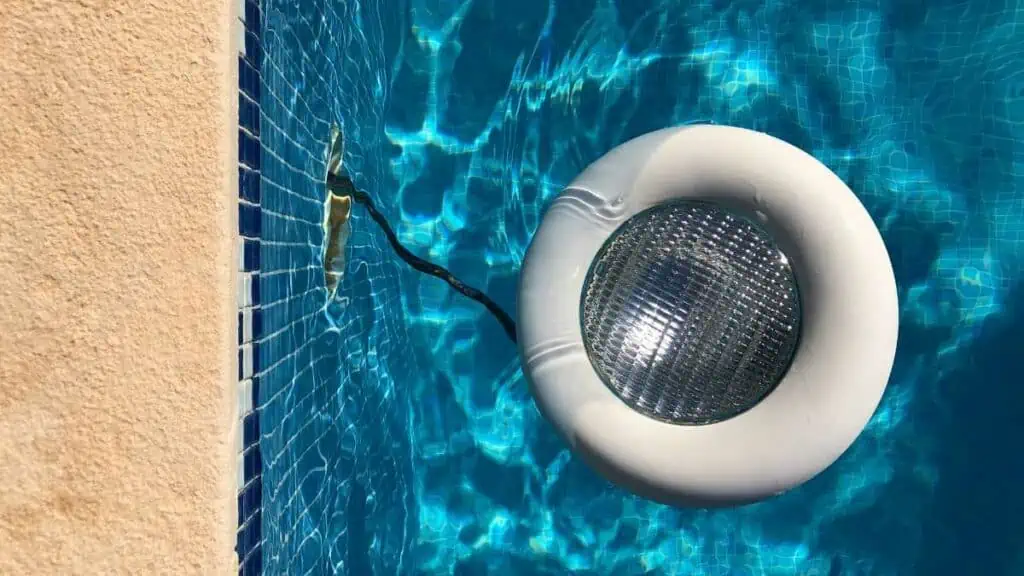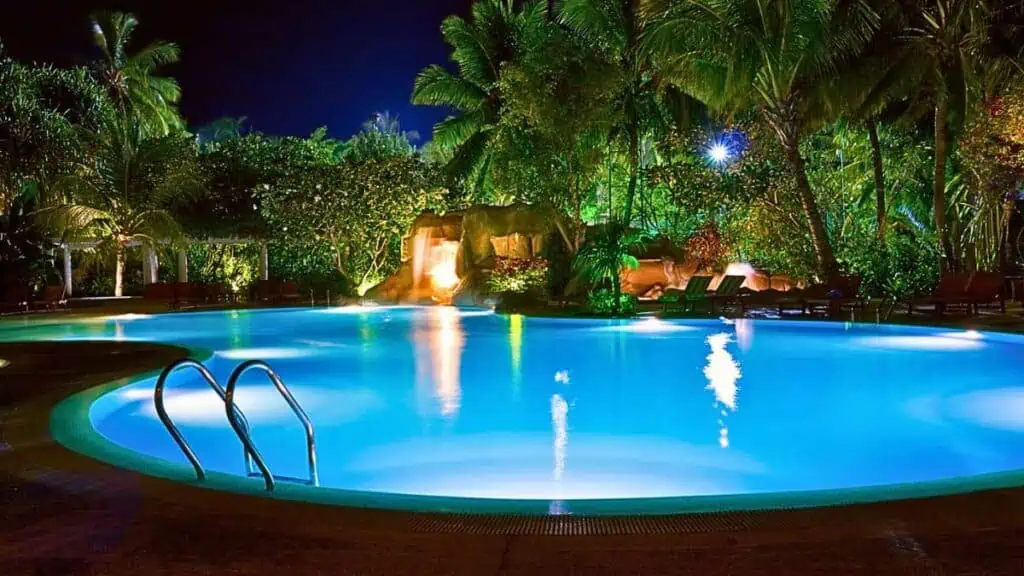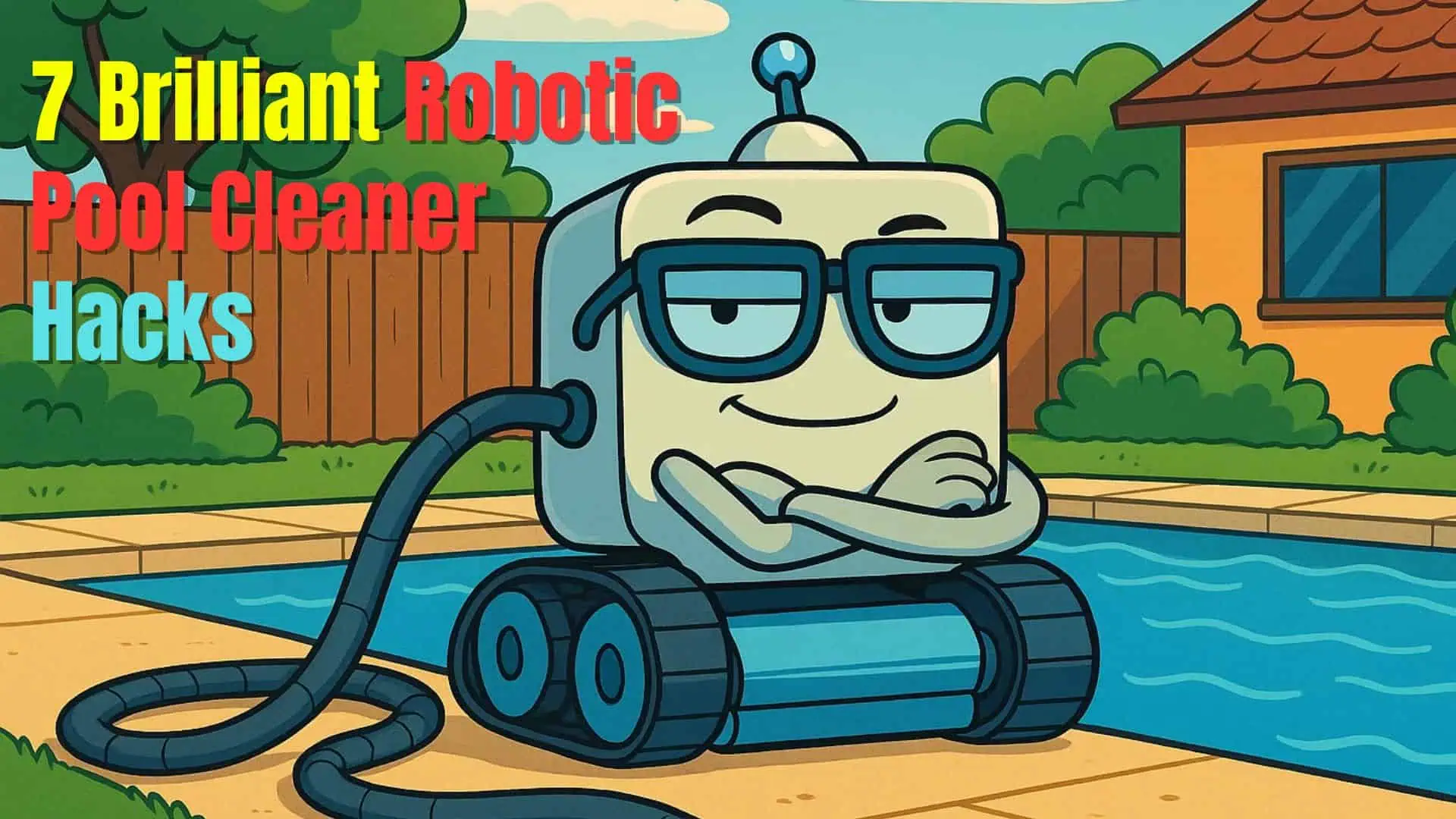As the sun goes down and darkness blankets the landscape, nothing quite elevates the ambience of your backyard pool like the gentle glow of a pool light. However, when that light stops working, you may find yourself unsure of how to change a pool light and whether you can do it yourself.
Changing your pool light may seem like a daunting task, but it doesn’t have to be and hopefully, we can demystify the process for you.
This article provides straightforward, step-by-step instructions to ensure safety and precision in completing this task. We will discuss everything you need to know about changing a pool light, whether you’re a seasoned pool owner or new to the task.

Safety Precautions
As most people are aware electricity and water don’t mix!
Before you begin the process of changing a pool light, it’s crucial to prioritize your safety and the safety of those around you. Here are some key safety precautions to consider:
Switch Off Power Supply
First and foremost, always switch off the power supply connected to your pool and its lighting system. Locate the circuit breaker box that controls the electricity flow to your pool and flip the switch to the “off” position.
Remember to exercise caution around electrical sources, as disregarding this step can lead to severe electrical shock or electrocution.
It’s essential to ensure that no electricity is being supplied to the pool before continuing. In the event of any doubts or concerns, consult a licensed professional to help you with the task.
Non-Contact Voltage Tester
After switching off the power supply, consider using a non-contact voltage tester to double-check that there’s no residual energy flowing through the wiring. This device detects electrical fields around the wires without actually touching them, minimizing the risk of electrical shock.
To use a non-contact voltage tester, bring the device near the pool light wiring and observe its response. If it lights up or beeps, there is still an active electrical current, and it’s unsafe for you to proceed. In this case, it’s best to consult a professional before taking any further steps.
How to Replace a Pool Light
Things You May Need to Change Pool Light
• A replacement pool light bulb
• Pool light gasket
• Phillips and flat head screwdrivers
• a circuit tester
• Dry towels
1. Drain Water
Before you start, you may want to drain your swimming pool to a level below the pool light. This will probably make removing the light easier but it is not essential.
I didn’t drain the pool when I changed mine and managed quite easily without it.
2. Remove Pool Light Fixture
Once the water level is low enough, go ahead and shut off all power to the pool lighting. This can be done at your home’s circuit breaker box, where there should be a designated breaker marked “pool.” Switch this breaker into the “off” position.
With the power off, locate your pool light. Most pool lights have a metal or plastic faceplate attached with screws. Using a screwdriver, gently unscrew the screws holding the faceplate, holding the fixture in place. Carefully remove the faceplate and fixture from the pool wall.
3. Detach the Fixture from the Wall

Now that you have access to the pool light fixture, you’ll need to detach it from the wall. To do this, look for a tab, screw, or other attachment holding the fixture in place. Carefully unscrew or unclip the fixture. It’s a good idea to have a towel handy to lay the fixture on, especially if it’s wet.
4. Check for Leaks
Before changing your pool light, it’s essential to inspect for any leaks in the light fixture or surrounding area. Keep an eye out for signs of rust or water stains around the light niche.
You can also use a towel to dry the area and check for any seepage. Identifying and fixing leaks early on is crucial in preventing further damage to your pool lighting system and maintaining its structural integrity.
5. Change the Bulb
With the fixture detached from the wall, it’s time to replace the light bulb. While holding the fixture steady on a towel, locate the gasket and carefully remove it. Next, unscrew the old bulb and discard it.
Make sure to purchase a compatible replacement pool light bulb before proceeding. Take your new bulb and carefully screw it into place, being careful not to overtighten it. Once the new bulb is securely in place, reattach the gasket, ensuring that it’s properly aligned.
6. Properly Seal the Light Fixture
After you have checked for leaks and replaced the bulb, it’s time to take steps to ensure your light fixture is adequately sealed. This will help prevent any water from entering or damaging the light fixture. Here are some steps to follow:
- Use a pool light gasket: Make sure you have the right size pool light gasket for your light fixture. The gasket creates a waterproof barrier between the lens and the light niche, preventing water from entering. Replace the gasket if it shows signs of wear or damage.
- Apply epoxy resin: Use a high-quality waterproof epoxy resin to seal any cracks or gaps around the cord entry hole in the light niche. This will further prevent any water from seeping through and causing damage.
- Tighten the clamps: Ensure that the clamps holding the light fixture in place are securely tightened. Loose clamps can cause the fixture to shift, compromising the seal and allowing water to enter.
By taking these measures to prevent leakage and damage, you can ensure your pool light remains functional for years to come. Remember that proper sealing and maintenance play a crucial role in the longevity of your pool light.
7. Now Replace Pool Light Fitting
After changing the pool light bulb, it’s time to reinstall the light fixture. Hold the light fixture up to the niche box and align it properly. Make sure the wiring is tucked neatly inside the niche box without any pinched wires or other issues.
Once everything is in place, use the appropriate fasteners or screws to secure the light fixture to the niche box according to the user manual. Tighten the fasteners evenly and adequately but avoid over-tightening them, which might cause cracking or breakage.
8. Test the Light After Installation
Before turning on the light, double-check that all components are correctly installed and secured. Ensure that the swimming pool’s power supply has been turned back on by switching the circuit breaker to the “on” position.
Now, test the pool light to verify it’s functioning well. Activate the light switch, and observe the pool light to confirm that it’s operating as it should. If you notice any issues, consult the user manual for troubleshooting guidance.
Maintaining safety and security is vital during pool light replacement. Always follow the manufacturer’s guidelines and precautions during the installation process to ensure the best and safest results.

Types of Pool Lights and Bulbs
LED Pool Lights
LED pool lights have become a popular option due to their energy efficiency, long lifespan, and impressive color capabilities.
These underwater lights typically use low voltage (around 12V) and have a wide range of available colors to create a stunning atmosphere in your pool. Some LED pool lights even come with remote controls, allowing you to easily switch between different colors and effects.
Read: LED Pool Lighting – Are LED Pool Lights Worth Installing?
Halogen Bulbs
Halogen bulbs are another type of pool light, known for their bright, white light and relatively low initial cost. However, they consume more energy than LED bulbs and have a shorter lifespan, meaning you’ll need to replace them more frequently.
Halogen bulbs usually come in a standard wattage of 100W or 300W.
Different Colors and Wattage
Both LED and halogen bulbs are available in different colors and wattage options. The color options for pool lights include:
- White: Bright and clean illumination, perfect for swimming at night.
- Blue: Creates a calming, serene atmosphere.
- Green: Perfect for creating a tropical-themed oasis.
- Red: An exciting and invigorating color that adds a touch of drama.
When it comes to wattage, LED pool lights are available in a low to high watt range, while halogen bulbs usually have set wattage options such as 100W or 300W. Pay attention to the label on the bulb to ensure it’s compatible with your pool light fixture.
Remember to always put safety first when working with pool lights – shut off all power to the pool lighting at your home’s circuit breaker box before attempting any changes or replacements. Happy swimming!
Choosing Between DIY or Hiring a Pro
Cost Comparison
When it comes to replacing a pool light, the cost of DIY versus hiring a professional can make a significant difference. DIY can save you money on labor costs, but you’ll need to purchase the necessary equipment and LED light bulb yourself.
On the other hand, hiring a pro means paying for their expertise and equipment, but they’ll handle the entire process for you. Compare costs of DIY equipment and professional services to decide what is more budget-friendly for your situation.
Weighing the Risks
Changing a pool light comes with a few risks and hazards. If you’re uneasy with anything involving electrical work or not confident in your ability to follow the manufacturer’s instructions, hiring a professional might be the better choice for you.
DIY Risks:
- Potential electrical hazards
- Not following manufacturer instructions
- Improperly sealing the light fixture, causing water damage
- Risk of damaging surrounding pool components
Hiring a Pro Risks:
- Increased cost compared to DIY
- Finding a reputable and experienced professional
To help you decide, consider your level of experience in pool maintenance, your ability to follow detailed instructions, and the amount of time you have available to commit to the project.
Troubleshooting Pool Lights
Common Pool Light Issues
Many pool light issues, such as a bulb not turning on or leaks in the light housing can be resolved through simple troubleshooting. Here are some common problems and potential solutions:
- Burnt-out bulb: If your pool light is not turning on, it might be due to a burnt-out bulb. Replace the pool light bulb with a suitable replacement, making sure to turn off the circuit breaker before performing any maintenance.
- Loose or damaged screws: If you notice your pool light is not securely fastened, grab a screwdriver and tighten the screws. Ensure you have a good-quality O-ring in place to prevent water leakage.
- Electrical issues: If you are experiencing issues with the voltage or wire connections, an electrician can help inspect and repair your pool light’s mainline.
Frequently Asked Questions
Can I replace my own pool light?
You can replace your own pool light. With the right tools and steps, it’s not as complicated as it may seem. Just make sure to gather everything you need in one place, including a replacement pool light bulb, and follow safety guidelines.
Is it expensive to change a pool light?
The cost of changing a pool light can vary depending on several factors such as the type of light and labor costs if you hire a professional. However, LED lights are energy-efficient and last longer than traditional halogen bulbs, which can save you money in the long run.
When should I replace my pool light?
You should replace your pool light when it no longer functions, appears dim, shows signs of corrosion or you want to swap out regular bulbs for LED bulbs. Regular maintenance of your pool light can extend its lifespan and ensure proper functioning.
What is the cost of pool light bulb replacement?
The cost of pool light bulb replacement depends on the type of bulb. LED bulbs are more expensive upfront but can save you money in the long run due to their energy efficiency and longer lifespan. Halogen bulbs are less expensive but may need to be replaced more frequently.
How do I change the color of my pool light?
To change the color of your pool light, you can either purchase a colored LED bulb or use a colored lens cover. Make sure to choose the appropriate product for your specific pool light model.





Leave a Reply